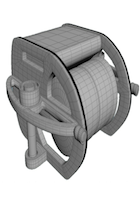D.A.V.E Your Autonomous Diving Buddy

D.A.V.E. is a new kind of diving buddy. He's an autonomous, modular underwater robot that doesn't fear dirty or cold water. You can build it, maintain it and modify it to fit your needs or upgrade it with the latest community improvements.
D.A.V.E. is an Open-Source and crowdfunded project that can be developped by everyone, for everyone.
Use case number one : hull inspections
Hull maintenance of large boats is dangerous, extremely expensive and time intensive.
In order to list the maintenance works that needs to be carried on the hull, on board engineers carry regular underwater hull inspections with the help of on board divers or contractors.
So far, divers have been the only way to carry hull inspections, as they are the only ones able to carry underwater cameras and take videos of the hull. They are also the only ones able to detect and film "points of interest" on the hull (propellers, thrusters, sensors...) and check their states.
In the luxury yacht industry, these inspections are carried during low activity, usually during winter while the boat is in port.
Hull inspections are either carried by the crew or by a contractor, which means they need to be carried during low activity times and in ports. The crew responsible of this task is removed from its daily job during several hours and contractors are only available in ports.
Diving in cold and dirty water is not the most pleasant activity and makes contractor bill high for their services. It is also time consuming for the on board team, as they need to check and clean their gears and are not able to do other work during this time.

In addition, diving in a port is dangerous, and divers were killed while doing hull inspections in the past. With so much traffic, human mistakes can easily be lethal in that environment.
They can get crushed between two hulls or sucked into a propeller as the captain of a maneuvering boat nearby may not have seen the diver down flag. It also happened a few times that on board engineers may start testing the thrusters, not being aware a hull inspection is being carried out at the same time.
With D.A.V.E., you can now reduce the manpower needed to carry hull inspection. It can save lives by reducing risks, avoid the discomfort of diving in cold and dirty waters and the expense of sending a diver to do this task.
It is as simple as that : replacing manned hull inspection by automated hull inspection; using D.A.V.E. and carry these jobs anywhere and anytime: the robot doesn't care of the temperature or the cleanliness of water and doesn't need supervision. This is essential : the robot needs to be completely autonomous while inspecting, with no need of human control, and costs far lower than a human life in case of accident.

Other uses of D.A.V.E.
As a modular experimental platform, D.A.V.E. can be used for a lot of different tasks.
So, if for instance you have to explore a place you don't want to go, such as an underwater cave or a ship wreck, send D.A.V.E.! He will reco the site for you without putting your life at risk, and come back to you once done.
Or if you're diving with beginners you can ask D.A.V.E. to film your dive while you focus on assisting others. They will feel secured with you taking care of them and will be happy to see the footage of their first dive!
Do you have an underwater job to carry and feel too bulky with your tools? Equip D.A.V.E. with a toolkit and ask him to follow you, so you'll always have the right spanner with you. Or ask him to light up your working area!
Another great thing about D.A.V.E. is that it is fully documented as an OpenSource project. So anyone interested in developing aplications for D.A.V.E. can get started right away.
D.A.V.E. can be more than an autonomous diving buddy. Ir can become an underwater roboti modular platform that can be infinitely expanded with modular accessories and make diving life safer, easier and a little more fun.
Team and experience
Bruno Messin – NavLab Founder / FabManager
After studying mobile robotics in Toulouse, Bruno worked for a company specialized in audiovisual systems integration. He was quickly involved as project manager of the installation of the audiovisual, IT and electronics systems of the luxury yacht MY Sarafsa II (82m), built at the naval shipyard of Devonport in Plymouth, UK.
After 4 years working on this 3 million Euro project, and once delivered, Bruno joined the luxury yacht MY Ice (90m) as on board AV/IT engineer. He then worked for more than 3 years on the luxury yacht MY Ecstasea (86m) as Lead ETO (Electro-Technical Officer).
While sailing around the world on board, Bruno understood the potential of opening a fabrication community workshop, specialized in yachting to untap the great possibilities offered by digital manufacturing for this industry. So he decided to launch the NavLab in Antibes, the first nautical Fablab in the world.
Bruno is not an experienced diver, but he worked with dive instructors and other underwater professionnals and he understood there was something usefull to be done to reduce risks and ease divers' life, so he decided to initiate the D.A.V.E. project.
David Saber – 2D/3D Infographist
David met Bruno at the NavLab, when he was looking for a coworking space to set up his freelance project : Dreamcraft Digital. As an experienced 3D modeler, David got excited to work on the D.A.V.E. project and he started to design the shape of our underwater robot.
For information regarding the crowdfunding campaign, contact bruno@navlab.fr or visit www.navlab.fr

Post your comment
You cannot post comments until you have logged in.
Login to post a commentComments
No one has commented on this page yet.
RSS feed for comments on this page | RSS feed for all comments